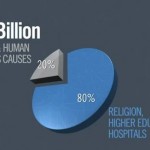 While most of us working in the non-profit world have been trained with the line of thinking that we need to be as frugal as possible in all areas of our organization, keeping overhead to 23% or less, there is another school of thought, which borrowing from the corporate world, says non-profits should spend more to make more.
While most of us working in the non-profit world have been trained with the line of thinking that we need to be as frugal as possible in all areas of our organization, keeping overhead to 23% or less, there is another school of thought, which borrowing from the corporate world, says non-profits should spend more to make more.
In his book, Uncharitable, Dan Pallotta discusses the restraints of public expectations on non-profits and their spending. These often unrealistic expectations affect all aspects of non-profit organizations from trying to find ways to advertise with little or no marketing budget, to offering below average wages to organization employees. Even with limited spending, public expectation for professional collateral is equal to that of large corporations. So, how do non-profits keep up?
 Pallotta’s approach of educating donors and helping them to see the value in what is often classified as “administrative costs”, could be a game changer for non-profits. Pallotta suggests explaining to donors that exposing new supporters to your organization’s cause could result in a tenfold increase in donations. In an era of shrinking budgets and a decline in donors, education and communication of this kind should be very valuable to non-profit organizations. Pallotta calls it a necessity, not only regarding administrative expenses, but in employing all corporate world strategies which would benefit non-profits.
Pallotta’s approach of educating donors and helping them to see the value in what is often classified as “administrative costs”, could be a game changer for non-profits. Pallotta suggests explaining to donors that exposing new supporters to your organization’s cause could result in a tenfold increase in donations. In an era of shrinking budgets and a decline in donors, education and communication of this kind should be very valuable to non-profit organizations. Pallotta calls it a necessity, not only regarding administrative expenses, but in employing all corporate world strategies which would benefit non-profits.
Whether your organization is willing to spend more money on acquisitions or not, Vacation Homes for Charity is holding a golden key to more revenue for non-profits. We estimate that vacation homes are sitting empty 85% of the time. With 6 million vacation homes on the market, there is the potential for charities to tap into this new revenue stream.




